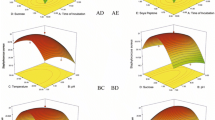Abstract
Entomopathogenic fungi are widely produced for use as mycoinsecticides. Therefore, improvement of the shelf life of fungal propagules under good and adverse conditions should be a pre-requisite of their production. In order to improve conidial physiology as well as mycoinsecticide efficiency, culture conditions may be varied. The Doehlert design was used to generate response surfaces with an estimation of the parameters of the quadratic model allowing the study of three different factors at a different number of levels. This experimental design was applied to optimize water activity (a w), pH, and fermentation time for Beauveria bassiana conidial production and accumulation of polyols in solid-state fermentation. Thus, it was possible to identify the region in the experimental range in which the optimum values of these parameters were simultaneously achieved. Maximal conidia production was achieved at pH 5–6 and a w=0.999. Under these conditions, polyol accumulation was 3 mg erythritol/g conidia and 29.6 mg glycerol/g conidia. However, maximal polyol accumulation was achieved at pH 4.5 and a w 0.950; erythritol production increased 33-fold and glycerol production 4.5-fold. Under these conditions conidia production was 1,000 times lower. The possibilities of increasing the quality of the biocontrol agent without neglecting yield are discussed.



Similar content being viewed by others
References
Alves SB, Pereira RM (1989) Production of Metarhizium anisopliae (Metsch.) Sorok and Beauveria bassiana (Bals.) Vuill. in plastic trays. Ecossistema 14:188–192
Araujo PW, Brereton RG (1996) Experimental design II. Optimization. Trends Anal Chem 15:63–69
Bartlett MC, Jaronski ST (1988) Mass production of entomogenous fungi for biological control of insects. In: Burges HD (ed) Microbial control pests and plant diseases. Academic Press, New York, pp. 60–85
Bidochka MJ, Low NH, Khachatourians GG (1990) Carbohydrate storage in the entomopathogenic fungus Beauveria bassiana. Appl Environ Microbiol 56:3186–3190
Chirife J, Favetto G, Ferro Fontan C (1984) Microbial growth at reduced water activities: some physicochemical properties of compatible solutes. J Appl Bacteriol 56:259–268
Diamant S, Eliahut N, Rosenthal D, Goloubinoff P (2001) Chemical chaperones regulate molecular chaperones in vitro and in cells under combined salt and heat stresses. J Biol Chem 43:39586–39591
Doehlert DH (1970) Uniform shell designs. Appl Stat 19:231–239
Dorta B, Ertola RJ, Arcas J (1996) Characterization of growth and sporulation of Metarhizium anisopilae in solid-substrate fermentation. Enzyme Microb Technol 19:434–439
Feng MG, Poprawski TJ, Khachatourians GG (1994) Production, formulation and application of the entomopathogenic fungus Beauveria bassiana for insect control: current status. Biocontrol Sci Technol 4:3–34
Gervais P, Molin P, Grajek W, Bensoussan M (1988) Influence of the water activity of a solid substrate on the growth rate and sporogenesis of filamentous fungi. Biotechnol Bioeng 31:457–463
Hallsworth JE, Magan N (1994) Effect of carbohydrate type and concentration on polyhydroxyalcohol and trehalose content of conidia of three entomopathogenic fungi. Microbiology 140:2705–2713
Hallsworth JE, Magan N (1995) Manipulation of intracellular glycerol and erythritol enhances germination of conidia at low water availability. Microbiology 141:1109–1115
Hallsworth JE, Magan N (1996) Culture age, temperature, and pH affect the polyol and trehalose contents of fungal propagules. Appl Environ Microbiol 62:2435–2442
Hallsworth JE, Magan N (1997) A rapid HPLC protocol for detection of polyols and trehalose. J Microbiol Methods 29:7–13
Jenkins NE, Heviefo G, Langewald J, Cherry AJ, Lomer CJ (1998) Development of mass production technology for aerial conidia for use as mycopesticides. Biocontrol News Inf 19(1):21N–31N
Moore D, Bateman RP, Carey M, Prior C (1995) Long-term storage of Metarhizium flavoviride conidia in oil formulation for the control of locusts and grasshoppers. Biocontrol Sci Technol 5:192–199
Moore D, Douro-Kpindou OK, Jenkins NE, Lomer CJ (1996) Effects of moisture content and temperature on storage of Metarhizium flavoviride conidia. Biocontrol Sci Technol 6:51–61
Ooijkaas LP, Wilkinson EC, Tramper J, Buitelaar RM (1999) Medium optimization for spore production of Coniothyrium minitans using statistically based experimental designs. Biotechnol Bioeng 64:92–100
Pascual S, Melgarejo P, Magan N (2002) Water availability affects the growth, accumulation of compatible solutes and viability of the biocontrol agent Epicoccum nigrum. Mycopathologia 156:93–100
Pfyffer GE, Rast DM (1980) The polyol pattern of some fungi not hitherto investigated for sugar alcohols. Exp Mycol 4:160–170
Ruijter GJG, Visser J, Rinzema A (2004) Polyol accumulation by Aspergillus oryzae at low water activity in solid-state fermentation. Microbiology 150:1095–1101
Steppan D, Werner J, Yeater B (1998) Essential regression and experimental design. www.geocities.com/SiliconValley/Network/1032
Taragano VM, Pilosof AMR (1999) Application of Doehlert designs for water activity, pH, and fermentation time optimization for Aspergillus niger pectinolytic activities production in solid-state and submerged fermentation. Enzyme Microb Technol 25:411–419
Van Eck JH, Prior BA, Brandt EV (1993) The water relations of growth and polyhydroxy alcohol production by ascomycetous yeasts. J Gen Microbiol 139:1047–1054
Van Zyl PJ, Prior BA (1990) Water relations of polyol accumulation by Zygosaccharomyces rouxii in continuous culture. Appl Microbiol Biotechnol 33:12–17
Youxing Q, Bolen CL, Bolen DW (1998) Osmolyte-driven contraction of a random coil protein. Biophysics. Proc Natl Acad Sci U S A 95:9268–9273
Acknowledgements
We thank Mariana Maggi for her skilful technical assistance. The authors are indebted to the National Research Council of Argentina (CONICET) and the University of Buenos Aires (UBA) for partial financial support. A. S. Couto is a Research Member of CONICET. Federico Tarocco is a fellow of the ANPCyT (Argentina).
Author information
Authors and Affiliations
Corresponding author
Rights and permissions
About this article
Cite this article
Tarocco, F., Lecuona, R.E., Couto, A.S. et al. Optimization of erythritol and glycerol accumulation in conidia of Beauveria bassiana by solid-state fermentation, using response surface methodology. Appl Microbiol Biotechnol 68, 481–488 (2005). https://doi.org/10.1007/s00253-005-1901-x
Received:
Revised:
Accepted:
Published:
Issue Date:
DOI: https://doi.org/10.1007/s00253-005-1901-x




